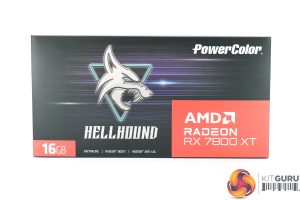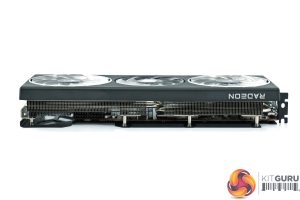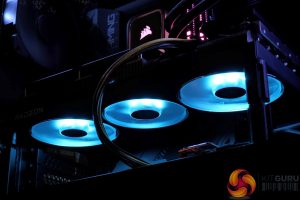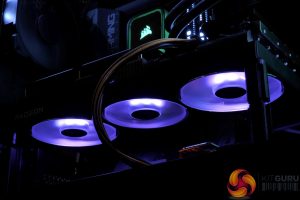The PowerColor RX 7800 XT Hellhound ships in a mostly black box, but with the Hellhound logo dominating the front. AMD Radeon branding is positioned in the bottom left corner. On the back, PowerColor highlights various key features of the card, as well as system minimum requirements.
Curiously, there were no additional accessories or quick start guides in the box. It's hardly the end of the world, and it's possible that I got an early press sample, but we've asked PowerColor if this will be the case for final retail units too.
As for the card itself, it's a relatively simple-looking card, but in quite a good way I think. The shroud is made of dark grey plastic and doesn't feature any raised sections or sharp angles, giving it a fairly stripped-back appearance that I think works well.
The three fans grab your attention, too, with their translucent fan blades, designed to amplify the LED lighting (as shown below). Interestingly, the central fan is smaller than the outer two at 90mm, while the others measure 100mm across. The central fan also spins in reverse, a now-common feature designed to reduce airflow turbulence.
In terms of its dimensions, the Hellhound measures in at 322 mm x134 mm x 50 mm. It's not small, but nor is it a monster in the vein of an RTX 4090. It weighed in at 1261g on my scales.
The front side of the card is left very open, allowing a good chunk of hot air to escape from the heatsink. As for the backplate, this is made of metal and spans the length of the card, but with four small cut-outs towards the end to allow air to pass through the heatsink. We can also note the dual-BIOS switch positioned next to the I/O bracket, giving users a choice of either the OC or Silent modes. The OC BIOS increases power, clocks and fan speed compared to Silent, but we test both later in this review.
There's another switch next to the power inputs, and this controls the LED lighting. You can either set it to Ice Blue, Amethyst Purple or completely off. While I've nothing against the two colours shown, I do find this approach slightly odd – I can only assume PowerColor wanted to avoid RGB lighting to keep the cost down, or help segment the Hellhound and Red Devil series slightly. It's not the end of the world but I think the option for RGB lighting would work very nicely with these translucent fan blades.
Elsewhere, we find two 8-pin power connectors, while display outputs are standard, with 3x DisplayPort 2.1 and 1x HDMI 2.1.
Taking the card apart to look at the PCB, PowerColor has deployed a healthy VRM, with twelve phases for the GPU and three for the memory. More specifically, PowerColor tells us the configuration is as follows: ‘9x VGFX, 2x VSOC, 1x VUSR1 for GPU, 2x VMEM, 1x VDDC 1 for mem.'
PowerColor claims this configuration is capable of delivering well over 300W to the GPU. Specifically, PowerColor is using the Monolithic Power System MP2857 controller for the GPU VRM, while a MP2856 takes care of the memory VRM. 70A Monolithic MP87997 MOSFETs are used throughout.
The cooler, meanwhile, utilises two hefty fin stacks, connected by a total of 5x 6mm heatpipes. The GPU die and memory modules contact with one baseplate, while there are a couple others to cool the VRM.
 KitGuru KitGuru.net – Tech News | Hardware News | Hardware Reviews | IOS | Mobile | Gaming | Graphics Cards
KitGuru KitGuru.net – Tech News | Hardware News | Hardware Reviews | IOS | Mobile | Gaming | Graphics Cards


















